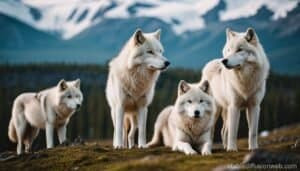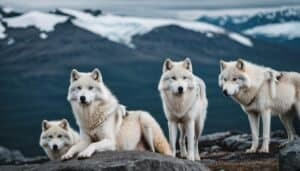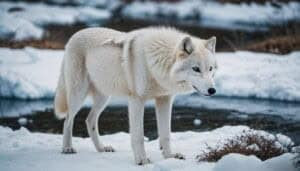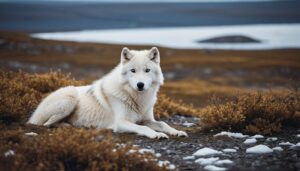Introduction
Arctic wolves are fascinating creatures that have developed unique adaptations to thrive in one of the harshest environments on Earth
This article will explore the various physical, physiological, and behavioral adaptations that enable these wolves to survive in the extreme cold of the Arctic. From their thick fur to their social behaviors, and their winter dietary habits, we will delve into how Arctic wolves manage to not only survive but flourish in their frigid habitat
Physical and Physiological Adaptations
Arctic wolves have developed several physical and physiological adaptations that allow them to withstand the extreme cold of their habitat. These adaptations include their thick fur, specialized paws, and specific physiological changes that enable them to maintain their body heat and survive in icy conditions
The Role of Thick Fur in Insulation
One of the most critical adaptations Arctic wolves have is their thick fur. This fur is composed of two layers: a dense, insulating undercoat and a longer, water-resistant outer coat
The undercoat provides essential insulation, trapping air close to the body and preventing heat loss. The outer coat, on the other hand, repels water and snow, keeping the inner layers dry and maintaining warmth
During the harsh Arctic winters, the fur of Arctic wolves becomes even thicker and more robust. This seasonal adaptation ensures that they are well-equipped to handle temperatures that can plunge well below freezing
The white coloration of their fur also serves as camouflage against the snow, aiding in both hunting and protection from potential predators
Adaptations of Arctic Wolves’ Paws
The paws of Arctic wolves are another vital adaptation for survival in their frigid environment. Their paws are large and covered with thick fur, which helps to distribute their weight more evenly across the snow, preventing them from sinking
This adaptation is crucial for moving efficiently across the icy terrain
Moreover, the pads of their paws are specially adapted to prevent freezing. They contain a high concentration of fat, which acts as insulation against the cold ground. Additionally, the blood vessels in their paws are arranged in a way that minimizes heat loss
This counter-current heat exchange system allows warm blood from the body to heat the cooler blood returning from the paws, maintaining a stable temperature and preventing frostbite
Physiological Changes for Cold Resistance
Beyond their physical traits, Arctic wolves exhibit several physiological changes that help them endure extreme cold. One such adaptation is their ability to slow down their metabolism during the harshest winter months. By reducing their metabolic rate, Arctic wolves can conserve energy and reduce the need for food, which can be scarce during winter
Another physiological adaptation is their ability to enter a state of torpor, a short-term hibernation-like state that helps them conserve energy. During torpor, their body temperature and metabolic rate drop, allowing them to survive periods of extreme cold and food scarcity
Additionally, Arctic wolves have a thick layer of body fat that provides insulation and energy reserves. This fat layer is particularly crucial during winter when hunting can be challenging, and energy needs are higher to maintain body heat
Behavioral Adaptations
In addition to their physical and physiological adaptations, Arctic wolves exhibit several behavioral adaptations that enhance their survival in the extreme cold. These behaviors include their social structure, hunting strategies, and sheltering practices, all of which contribute to their ability to thrive in the harsh Arctic environment
Social Structure and Survival
Arctic wolves live in packs, which is a crucial aspect of their survival strategy. The pack structure provides numerous advantages, especially in the frigid Arctic. Living in a group allows them to share body warmth, reducing the individual energy expenditure needed to stay warm
The close-knit social bonds also facilitate cooperative hunting, which is essential for bringing down large prey in a challenging environment
Within a pack, there is a clear hierarchy, with an alpha pair leading the group. This social structure ensures that there is order and coordination during hunts and when protecting their territory
It also helps in the raising and protection of pups, ensuring that the young have a better chance of survival in the harsh conditions
Hunting Strategies in Extreme Temperatures
Hunting in the Arctic requires specific strategies due to the extreme cold and the scarcity of prey. Arctic wolves often hunt in packs to increase their chances of success. Their primary prey includes musk oxen, Arctic hares, and caribou, which are often larger than the wolves themselves
By working together, they can take down these sizeable animals, ensuring that the entire pack has enough food
The wolves use their keen sense of smell and excellent vision to locate prey over vast distances. They are also known for their stamina, capable of traveling long distances in search of food
During hunts, they employ tactics such as flanking and surrounding their prey to increase the likelihood of a successful kill
Shelter and Denning Behaviors
Shelter is vital for Arctic wolves to protect themselves from the severe cold and wind. They typically use natural shelters such as caves or rock crevices to shield themselves from the elements. During the winter, they may also dig dens in the snow to create a warmer environment insulated from the harsh external temperatures
These dens are especially crucial for raising pups. Arctic wolves give birth in the spring when temperatures are still very cold. The dens provide a safe and warm space for the pups to grow until they are strong enough to face the outside conditions
The pack members take turns caring for and protecting the pups, ensuring their survival during the vulnerable early weeks of life
Diet and Survival in Winter
The diet and survival strategies of Arctic wolves are essential for their existence in the harsh Arctic environment. These wolves have adapted their feeding habits to cope with the extreme cold and scarcity of food during the winter months
This section explores their dietary habits, how they sustain themselves during the long winter, and how their pups adapt to the cold environment
Dietary Habits During Winter
Arctic wolves are carnivorous predators, and their diet mainly consists of large mammals that can provide ample nutrition and energy. In the winter, when prey is scarce, they rely heavily on hunting musk oxen, caribou, and Arctic hares
These prey animals are challenging to catch due to their size and speed, but hunting in packs increases the wolves’ chances of a successful kill
During the harsh winter months, Arctic wolves may also scavenge for food, eating carrion when live prey is not available. This opportunistic feeding behavior is crucial for their survival, as it allows them to take advantage of any available food source
Their strong jaws and teeth enable them to consume almost every part of their prey, minimizing waste and maximizing energy intake
Arctic wolves also exhibit a behavior known as “caching,” where they bury surplus food in the snow to consume later. This strategy ensures they have a food reserve during times when hunting is not possible or successful
How Pups Adapt to the Cold
The survival of Arctic wolf pups during the cold months is a testament to the species’ remarkable adaptability. Pups are born in the spring, but they face the challenge of growing and thriving in an environment that remains cold and harsh for much of the year
To protect the pups from the extreme cold, Arctic wolves give birth in dens that provide insulation and protection from the elements. These dens are often dug into the ground or snow and are lined with fur and other insulating materials to keep the pups warm. The pack members take turns guarding and caring for the pups, ensuring they stay safe and warm
The thick fur of Arctic wolf pups begins to develop shortly after birth, providing them with the necessary insulation to survive the cold. The pups also grow rapidly, which helps them build the strength and fat reserves needed to withstand the Arctic temperatures
Social interactions within the pack play a crucial role in the pups’ development. The pack’s communal care and protection ensure that the pups have a higher survival rate, as they receive constant attention and nourishment from multiple pack members
As the pups grow older, they learn essential survival skills from observing and participating in the pack’s activities. They practice hunting techniques and social behaviors that are vital for their integration into the pack and their future survival
Conclusion
Arctic wolves are extraordinary animals that have evolved a range of adaptations to survive in the extreme cold of their habitat. Their thick fur provides essential insulation, while their specially adapted paws allow them to traverse icy terrain efficiently
Physiologically, they can slow their metabolism and enter states of torpor to conserve energy during the harshest winter months. Behaviorally, their pack structure aids in warmth, cooperative hunting, and protection, all crucial for survival in the Arctic
Their diet is adapted to the scarcity of prey in winter, focusing on large mammals and occasionally scavenging or caching food to ensure they have enough to eat during lean times. Pups, born in the relative warmth of spring, are raised in insulated dens and benefit from the communal care of the pack, which helps them develop the necessary skills and strength to face the cold as they grow
These combined physical, physiological, and behavioral adaptations enable Arctic wolves to not only endure but thrive in one of the most challenging environments on Earth, showcasing the remarkable resilience and adaptability of this species










